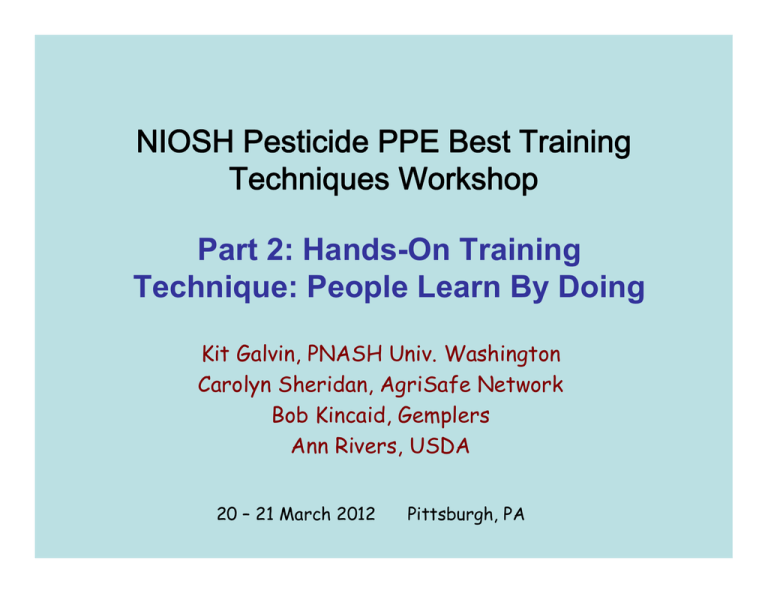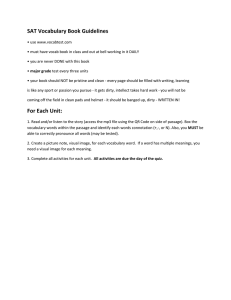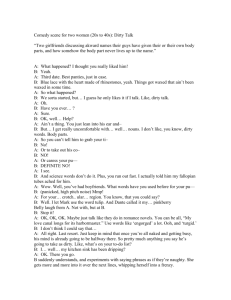NIOSH Pesticide PPE Best Training Techniques Workshop Part 2: Hands-On Training
advertisement

NIOSH Pesticide PPE Best Training Techniques Workshop Part 2: Hands-On Training Technique: People Learn By Doing Kit Galvin, PNASH Univ. Washington Carolyn Sheridan, AgriSafe Network Bob Kincaid, Gemplers Ann Rivers, USDA 20 – 21 March 2012 Pittsburgh, PA Objectives Provide rational for using hands-on Provide examples of hands-on activities Engage in a hands-on activity Why Hands-on? Uses different learning styles Bridges language and cultural barriers Engages participants TIPS Relevant Practical Realistic Focus - message Practice Checkout location in advance Flexible “Step Away from Your PPT” large audience Live Skit – Role Play Live FT skit > video FT skit > alt. video Foss et al: 2002. J Pesticide Safety Education 4:1-9 “Step Away from Your PPT” Respirator Inspection 1. Is it ready to use? Why? 2. Is it the correct part for the respirator? Why? Inspect your respirator “Get Your Hands Dirty” Unplugging a sprayer nozzle WSDA Role Play message actors props story cue cards questions discussion points Cue Cards #1 Cue Cards #2 Cue Cards #3 Cue Cards #4 “Get Your Hands Dirty” 12 steps Convey a message: “dirty to dirty & clean to clean” Darrell Kilgore, WSU Video Unit Practice skills: Darrell Kilgore, WSU Video Unit PPE Removal & Decontamination PNASH PNASH Dirty to Dirty Clean to Clean Darrell Kilgore WSU Video Unit Darrell Kilgore WSU Video Unit Darrell Kilgore WSU Video Unit “Get Your Hands Dirty” Fluorescent Tracer Dirty to Clean Dirty to Dirty PNASH PNASH “Get Your Hands Dirty” Farm PNASH Darrell Kilgore WSU Video Unit Location Outside Inside “Personal Touch” individual approach 1-4 people Hands on Interactive Demonstrations Head to Toe Protection Personal Protective Equipment Labels “Personal Touch” Head to Toe Protection Absorption rates of body why PPE is important Donning and doffing - proper methods of putting PPE on and taking PPE off Practical use - long sleeve long pants – when is that okay Personal Protective Equipment Having correct PPE available Audience Participation Glove sizing, Coverall sizing, Respirator Donning “Personal Touch” Labels Rubber gloves are not chemically resistant to all pesticide products. Using the wrong respiratory equipment can lead to inhalation exposure. Chemically resistant boots and gloves can trap fumigant pesticides near the skin and cause burns. Training for pesticide workers should emphasize PPE is selected based on label requirements and product use “Personal Touch” Labels – Proper PPE Example: Chemical-resistant gloves and footwear should not be worn when handling certain fumigant gasses, such as methyl bromide. Methyl Bromide Label Remember: PPE should be selected based on the requirements of a specific product label and how the product will be used Teach and Demonstrate Risk Assessment Conclusion “People Learn by Doing” hands-on activities interactive demonstrations relevant, practical, realistic, different sized audiences – large – small audience or breakout group – individual (1-4 people) Personal touch Q&A


